The Kadena Chicken Myth

USAF Myths and Urban Legends
Kadena AFB Hauntings and the 'Kadena Chicken'
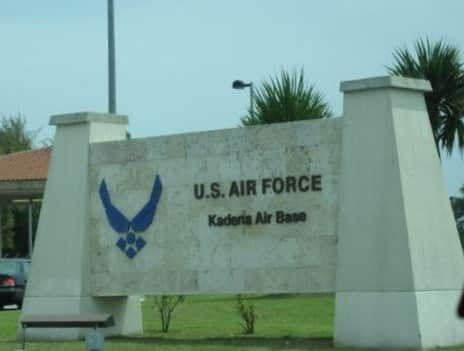
Hauntings
Kadena Air Base on the Japanese island of Okinawa is one of the U.S. military's most storied overseas postings. It was first captured from the Japanese during World War II and has been in continuous use ever since. It's also said to be haunted.
One of its base housing units was believed to be the site of a murder-suicide in the 1970s and has been haunted ever since. One of the base's gates gets a regular ghostly visitor in uniform asking for someone to light a cigarette. There's also the spectral figure of an old Japanese man that will murder someone else if he sees you.
The "Kadena Chicken"
Kadena Air Base is the home of the 18th Wing, an Air Force unit that predates World War II. The legend of the Kadena Chicken is based on the 18th Wing's insignia, which features a black chicken, with its wings held high on a yellow background mixed with the unit's history during the Korean War. The legend is pretty gruesome, but it's also completely false. It's also a way to get an old-timer riled up by telling them it's false because they are so sure that it really happened. Some arguments in bars have degenerated into fistfights.
18th Wing F-15 Eagle at Kadena AB
By the end of November 1950, the Korean War was not going well for North Korea. United Nations forces had almost pushed the Communist North Koreans to the Yalu River, its border with China. On Dec. 1, 1950, the 18th Fighter-Bomber Wing deployed to an air base near Pyongyang from its home in the Philippines, to support the UN move north.
While the 18th was getting settled near North Korea's capital city, the Chinese People's Volunteer Army intervened in the war and began pushing the UN back toward the 38th parallel. The UN made its "fighting withdrawal" against the overwhelming force as it moved south at a rapid pace.
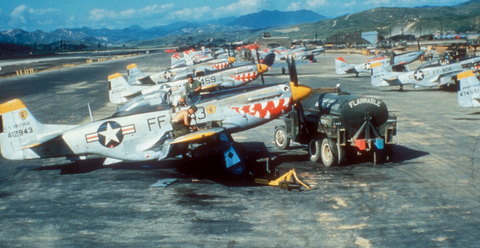
18th FBW P-51 Mustangs in Korea
The speed with which the UN was forced to move caught many by surprise. By Christmas Eve 1950, 100,000 UN troops and 14,000 North Korean refugees had to be evacuated at the port of Hungnam, on the peninsula's east coast, or be destroyed. The (untrue) Legend of the Kadena Chicken begins around the same time, back in Pyongyang.
Pyongyang sits on the opposite side of the peninsula, pretty deep inside North Korea. It's said that the 18th Wing was surprised by the Communist counterattack and its pilots abandoned the airmen on the ground, evacuating the base in their aircraft. The aircraft maintenance crews were left undefended and faced the combined Chinese-North Korean assault on their own. Reprisals from the Communists were said to be brutal. The men of the 18th Wing who were not killed outright were tortured and executed, with some being hung from the rafters of their aircraft hangars using aircraft safety wire or barbed wire.
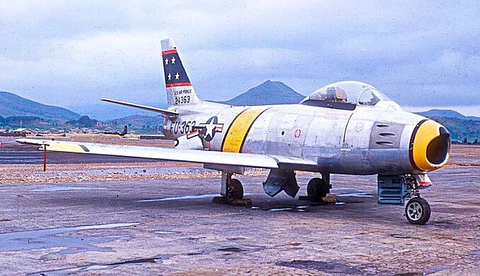
18th FBW F-86F Sabre in Korea
As a punishment, the story goes, the 18th Wing was forbidden by the Pentagon from having a home station in the continental United States until such time as they proved their bravery in combat. Further humiliation came from the Pentagon in the bestowing of an new insignia: a chicken with its wings in the air, surrendering on a yellow background to remind the 18th forever of its cowardice in the face of the enemy.
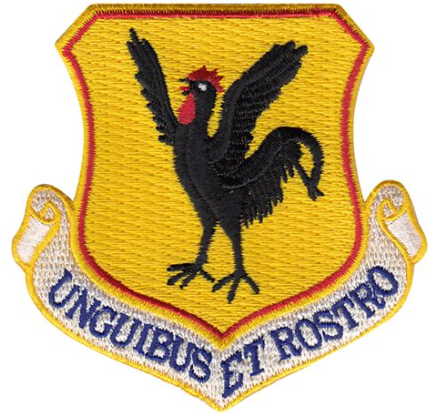
None of this ever happened. The 18th Fighter-Bomber Wing also evacuated in the face of the Chinese intervention, first moving to Suwon Air Base (a few miles from today's Osan Air Base) and then being forced to Jinhae Naval Base on the peninsula's southern tip. An alternate version of the story says the Americans fled in disgrace from Suwon.
Except the Americans didn't flee in terror at all. The 18th received a Republic of Korea Presidential Unit Citation for damaging or destroying thousands of enemy vehicles. Aircraft from the 18th Fighter-Bomber Wing were in Korea for the duration of the war, only moving to Kadena Air Base on Okinawa in 1954. In Korea it earned the unit the nickname "Truckbusters” and 45,000 combat sorties isn't what anyone would call "fleeing in terror."

As for the “cowardly chicken” emblem, it predates the Korean War. It was chosen in 1927 and first approved for use by the Army Air Corps in 1931, when the unit was still called the 18th Pursuit Squadron. The "chicken" isn't a chicken at all; it's a fighting gamecock. The unit motto "Unguibus et Rostro" is Latin for "talons and beak," meaning the unit fights with everything it has at its disposal.
In essence, while Kadena Air Base may be steeped in tales of the supernatural, the legend of the 'Kadena Chicken' serves as a reminder of the power of myth and the importance of separating fact from fiction in unraveling history's enigmatic narratives.
The Mysterious Black Goo Incident
The murky tale of the mysterious black goo incident at an undisclosed USAF base has left the airmen scratching their heads in bewilderment. It all started when a routine maintenance check on a B-2 bomber uncovered a sticky, gooey substance oozing from the aircraft's underbelly. No one could pinpoint the origin of this strange goo, and before they could analyze it, the substance mysteriously disappeared overnight, leaving behind a puzzling residue that defied scientific explanation.
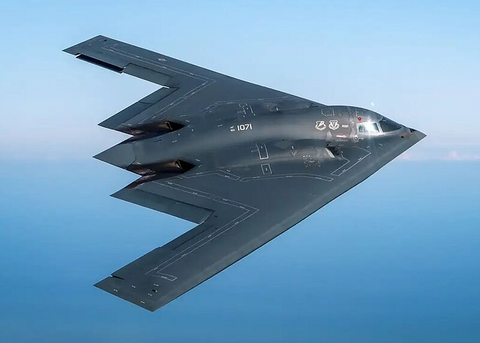
Rumors began to swirl among the base personnel, with some whispering about extraterrestrial involvement and others suspecting it to be a top-secret experimental material gone awry. The base went on high alert, and a thorough investigation was launched, but all leads turned up empty. To this day, the black goo incident remains shrouded in mystery, a cautionary tale of the strange and unexplained phenomena that lurk within the shadows of military installations.
B-21 Bomber Challenge Coin From Challenge Coin Nation
The Phantom Airman of Area 51
For those intrigued by the mysterious tales surrounding Area 51, the legend of the Phantom Airman is a must-hear. Rumored to roam the vast desert expanse in the dead of night, this spectral figure is said to be a ghostly reminder of a classified military experiment gone awry. According to local whispers, the Phantom Airman appears as a shadowy silhouette in full flight gear, haunting unsuspecting onlookers as they traverse the secluded desert roads.

Eyewitness accounts of encounters with the Phantom Airman describe a chilling presence that sends shivers down the spine. Some claim to have seen the ghostly figure standing silently on the tarmac of the restricted airfield, while others speak of a sudden gust of wind accompanied by the distant sound of phantom aircraft engines. Whether real or a product of overactive imaginations, the legend of the Phantom Airman continues to captivate believers and skeptics alike, adding another layer of intrigue to the enigmatic aura of Area 51.
The Haunted Hangar at Wright-Patterson AFB
A mysterious air of unease surrounds the mythical Hangar 18 at Wright-Patterson AFB. As the sun sets over the base, rumors of ghostly apparitions and eerie echoes fill the air, sending shivers down the spines of even the most experienced airmen. Legend has it that the spirits of fallen pilots from World War II still linger within the hangar's walls, their phantom footsteps echoing in the dead of night.
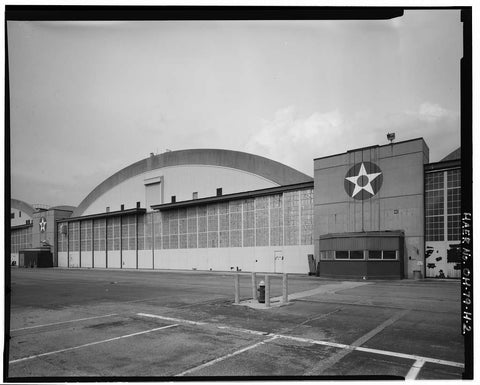
Despite numerous attempts to debunk the haunting tales, a sense of unease still pervades the hangar's atmosphere, leading many to speculate on the supernatural forces at play. Whether it's the flickering lights, unexplained shadows, or sudden drops in temperature, something inexplicable seems to lurk within the confines of Hangar 18, leaving visitors with chills running down their spines. The stories of the haunted hangar at Wright-Patterson AFB have become an integral part of the rich tapestry of urban legends that shroud the world of the United States Air Force.
The Curse of the Ghostly B-29 Bomber
Tales of the cursed B-29 bomber have circulated around air bases for decades. Legend has it that any crew that comes into contact with this ghostly aircraft meets a tragic fate. The eerie whispers of aircrew spirits are said to accompany the sound of the phantom bomber's engines in the dead of night.

Despite efforts to exorcise the aircraft of its curse, the haunting presence of the B-29 bomber lingers on, striking fear into the hearts of those who dare to cross its path. Many airmen have reported seeing shadowy figures in 1940s Air Force uniforms surrounding the aircraft on moonless nights, a reminder of the mysterious and tragic history that surrounds the ghostly B-29 bomber.
The Legend of the Lost Nuclear Warhead
Deep in the archives of the United States Air Force lies a story that has baffled historians and conspiracy theorists alike: the mysterious disappearance of a nuclear warhead during a top-secret mission in the early days of the Cold War. Legend has it that a B-47 Stratojet bomber carrying the deadly payload vanished without a trace over the Pacific Ocean, leaving behind only a trail of unanswered questions and speculation. Some believe it was a simple case of mechanical failure, while others are convinced that the warhead was intercepted by unknown forces with an agenda shrouded in secrecy.
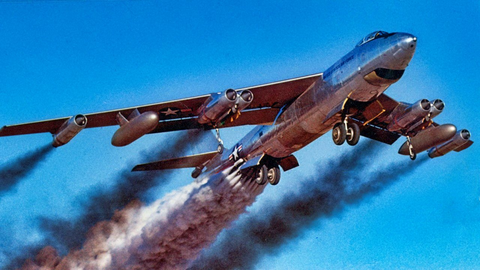
As the tale goes, the crew of the ill-fated bomber had been tasked with transporting the nuclear device to a classified location when communication was suddenly lost. Search and rescue efforts yielded no wreckage or survivors, leading many to speculate about the true fate of the lost warhead. Was it a case of human error or something more sinister lurking in the shadows of international espionage? To this day, the legend of the missing nuclear warhead continues to haunt the corridors of military history, a chilling reminder of the high stakes and hidden dangers of the Cold War era.
The UFO Encounter at RAF Bentwaters
The RAF Bentwaters incident is an old chestnut in the world of UFO lore. The story goes that back in 1980, a few USAF personnel stationed at the base witnessed strange lights in the sky. These lights were not your average shooting stars or passing satellites; they moved in ways that seemed to defy the laws of physics.
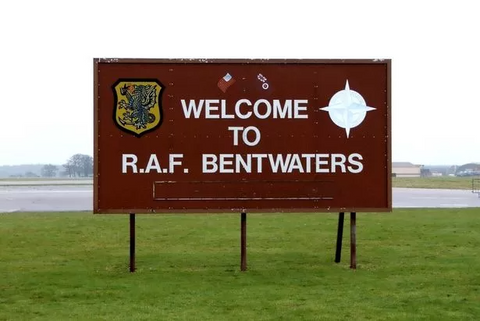
Even more intriguing were the eyewitness accounts of seeing a mysterious craft on the ground, complete with strange hieroglyphic-like symbols etched onto its surface. The official explanation was that it was all just a misunderstanding, perhaps a satellite or experimental aircraft gone astray. But for those who were there that fateful night, the memories of the encounter linger like a half-remembered dream. The truth may never be known, but the legend of the UFO encounter at RAF Bentwaters lives on in whispered conversations and internet forums dedicated to the unexplained.
The Ghostly Pilot of Edwards AFB
Ever heard the eerie tale of the ghostly pilot haunting the runways of Edwards Air Force Base? Legend has it that a brave airman from decades past still roams the tarmac, his spectral presence sending shivers down the spines of those who dare to tread where he once soared. The story goes that on foggy nights, a faint outline of a vintage aircraft can be seen taking off without a pilot in sight, leaving witnesses questioning the boundaries between reality and the supernatural.
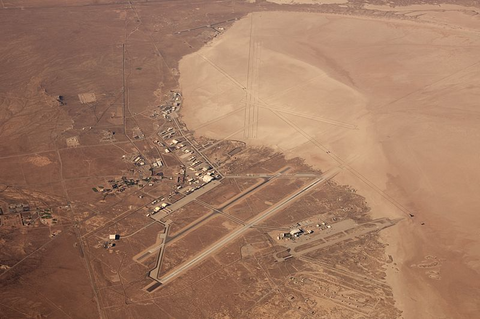
Rumors persist that the phantom pilot met a tragic end during a top-secret flight mission, his soul forever tethered to the base where he met his untimely demise. Some claim to hear the distant roar of engines and catch fleeting glimpses of a ghostly figure in aviator gear, a haunting reminder of the dangers that come with defending the skies. Whether you believe in ghosts or not, the tale of the ghostly pilot of Edwards AFB continues to intrigue and mystify those who venture into the realm of USAF urban legends.
Conclusion
Urban legends and myths surrounding the United States Air Force (USAF) have proliferated over the years, reflecting a blend of folklore, speculation, and occasional truths. From tales of experimental aircraft sightings in remote locales to rumors of top-secret bases hidden beneath the desert sands, these stories captivate imagination and often blur the lines between fact and fiction. Whether it's the legendary Area 51, purported encounters with extraterrestrial beings, or the enduring mystery of missing aircraft, USAF urban legends continue to fascinate and inspire speculation among enthusiasts and skeptics alike. Are they true? You be the judge.
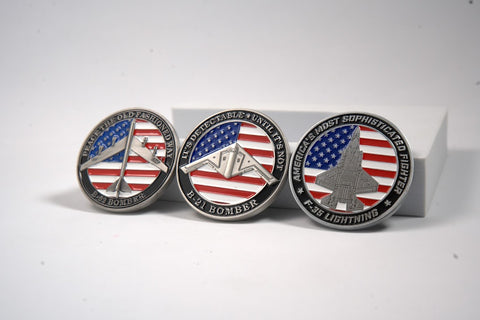
About Challenge Coin Nation
We at Challenge Coin Nation are a veteran founded company and are honored to be able to continue serving our brothers and sisters in arms all over the world. We sell many different military themed items, but challenge coins are our specialty. Check out some of our items below. Oh, and you might ask, “How much is shipping?” That’s an easy question. Shipping is free for custom coin orders – worldwide!
Shop for more coins at these pages:
Challenge Coin Nation Challenge Coins
Challenge Coin Nation Stock Challenge Coins
Challenge Coin Nation Custom Coins
Challenge Coin Nation Blue Falcon Military Coin
Throughout history, the military has been a fertile ground for the development of myths, urban legends, and ghost stories. These tales, passed down through generations, serve as both cautionary tales and a source of camaraderie among those who serve. They reflect the anxieties, hopes, and mysteries that surround the military experience, blending fact and fiction in ways that captivate the imagination. This essay explores some of the most enduring military myths, urban legends, and ghost stories, offering insights into their origins, meanings, and cultural significance.
1. The Phantom Soldier: Ghosts of the Battlefield
One of the most common themes in military ghost stories is the appearance of phantom soldiers. These apparitions are often said to haunt the sites of major battles, where the trauma of war has left an indelible mark on the landscape. One of the most famous examples is the ghost of the Battle of Gettysburg.
1.1 The Ghosts of Gettysburg
Gettysburg, the site of one of the bloodiest battles of the American Civil War, is often cited as one of the most haunted locations in the United States. Visitors and park rangers alike have reported seeing ghostly figures dressed in Civil War uniforms, hearing the sounds of battle, and experiencing sudden drops in temperature. Some claim to have seen entire phantom regiments marching across the fields, re-enacting the battle in spectral form.
The persistence of these ghost stories can be attributed to the sheer scale of the carnage at Gettysburg, where over 50,000 soldiers were killed, wounded, or went missing. The trauma of such a devastating event may have left an "imprint" on the location, according to believers in the paranormal. Skeptics, however, argue that these experiences are the result of suggestibility, the power of the imagination, or even natural phenomena such as mist and fog.
1.2 The Green Lady of Wahiawa
Another famous military ghost story is that of the Green Lady of Wahiawa, Hawaii. This legend centers on Schofield Barracks, a U.S. Army installation, where soldiers have reported encounters with a ghostly woman dressed in green. According to the legend, the Green Lady was a native Hawaiian woman who lost her child in the nearby gulch and now roams the area in search of her lost offspring. Soldiers who venture into the gulch at night are said to encounter her spirit, which is often accompanied by a strong floral scent.
The Green Lady legend reflects the intersection of Hawaiian folklore and military culture, blending elements of local mythology with the experiences of soldiers stationed far from home. It serves as a reminder of the deep connection between place and memory, as well as the ways in which cultural stories adapt to new contexts.
2. Urban Legends of the Military: Fact or Fiction?
Urban legends are stories that are widely circulated as true, though they often contain elements of exaggeration or distortion. In the military, these legends often take the form of cautionary tales, intended to warn service members of potential dangers or to instill a sense of awe or respect for certain traditions. While some urban legends have a basis in fact, others are entirely fictional, serving as a form of entertainment or moral instruction.
2.1 The Vanishing Hitchhiker
One of the most famous military urban legends is the story of the vanishing hitchhiker. This tale typically involves a soldier who picks up a hitchhiker while driving late at night. The hitchhiker, often described as a young woman dressed in white, provides directions to a nearby location before mysteriously disappearing from the vehicle. When the soldier later investigates, he discovers that the location is a cemetery, and the hitchhiker is revealed to be the ghost of someone who died in a car accident or other tragic event.
The vanishing hitchhiker legend is not unique to the military, as similar stories are found in many cultures around the world. However, the military version of the tale often emphasizes the themes of duty, sacrifice, and the enduring presence of those who have passed on. The story serves as a reminder of the transient nature of life and the bonds that connect the living and the dead.
2.2 The Myth of the Super Soldier
Another prevalent military urban legend is the myth of the "super soldier" – a warrior enhanced by secret government experiments to possess extraordinary strength, speed, or endurance. This legend has its roots in real-world attempts by militaries to create better soldiers through training, technology, and even pharmaceuticals. For example, during World War II, both the Allies and Axis powers experimented with stimulant drugs to keep soldiers alert and combat-ready.
The myth of the super soldier has been popularized by films, video games, and comic books, where characters like Captain America represent the ultimate warrior, created through a combination of science and sheer willpower. While the idea of a super soldier is appealing, it is largely a product of fiction. Real-life attempts to enhance soldiers' abilities have faced significant ethical, medical, and practical challenges, and the notion of a perfectly engineered warrior remains far from reality.
2.3 The Tale of the "Dear John" Letter
The "Dear John" letter is an infamous aspect of military lore, referring to a letter received by a soldier from a romantic partner ending their relationship. The stereotype is that soldiers deployed overseas frequently receive such letters, leading to heartbreak and sometimes drastic consequences.
While the "Dear John" letter is based on real occurrences, its prominence in military culture has been amplified to the level of an urban legend. The story often serves as a cautionary tale about the challenges of maintaining relationships during long deployments. In some versions of the legend, the soldier reacts by performing acts of heroism, while in others, the news leads to tragic outcomes.
The "Dear John" letter legend reflects the emotional toll of military service and the difficulties of sustaining personal connections in the face of prolonged separation and stress. It also highlights the vulnerabilities of those who serve, reminding us that even the strongest warriors are not immune to matters of the heart.
3. Myths and Misconceptions: Military Culture and History
Myths and misconceptions about the military are pervasive, shaping public perceptions and influencing how soldiers view themselves and their service. These myths often arise from a combination of historical events, cultural attitudes, and the complexities of military life. While some myths are relatively harmless, others can have significant implications for how the military is understood and how veterans are treated.
3.1 The Myth of the Invincible Army
One of the most enduring military myths is the notion of the "invincible army" – the belief that certain military forces are unbeatable, either due to superior technology, training, or divine favor. This myth has been perpetuated throughout history, from the Spartan warriors of ancient Greece to the British Empire and modern superpowers like the United States.
The myth of invincibility can lead to dangerous overconfidence, both within the military and among the civilian population. It can also contribute to unrealistic expectations about the outcomes of military engagements, leading to disillusionment when victories are not as swift or decisive as anticipated. In reality, history is replete with examples of seemingly invincible armies being defeated by less powerful opponents, demonstrating the importance of strategy, adaptability, and the human element in warfare.
3.2 The "Band of Brothers" Myth
The "band of brothers" myth is a romanticized view of military service, emphasizing the deep bonds of camaraderie and loyalty that develop among soldiers. This concept has been popularized by films, literature, and television series, most notably the HBO miniseries Band of Brothers, which portrays the experiences of Easy Company during World War II.
While it is true that strong bonds often form among soldiers who serve together, the "band of brothers" myth can sometimes obscure the complexities of military life. Not all soldiers experience such close-knit relationships, and the pressures of combat, long deployments, and the hierarchical nature of the military can also lead to tensions and conflicts. Moreover, the focus on male camaraderie can sometimes marginalize the experiences of women and other minority groups within the military.
The "band of brothers" myth serves as both an ideal and a point of contention within military culture. It highlights the importance of teamwork and mutual support while also prompting critical reflection on the diverse experiences of those who serve.
3.3 The Myth of the "Clean War"
The myth of the "clean war" is the belief that modern warfare can be conducted with precision and minimal collateral damage, thanks to advances in technology and the application of strict rules of engagement. This myth has been particularly prevalent in the context of drone warfare and other forms of remote combat, where the use of precision-guided munitions is seen as a way to limit civilian casualties and avoid the horrors of traditional battlefield engagements.
However, the reality of warfare is far messier than this myth suggests. Despite technological advances, war remains inherently destructive, and even the most precise weapons can result in unintended harm. The myth of the "clean war" can create unrealistic expectations about the conduct of military operations, leading to ethical dilemmas and difficult decisions for those in command. It can also obscure the long-term consequences of war, including the impact on civilian populations, the environment, and the psychological well-being of soldiers.
4. The Role of Myths and Legends in Military Life
Military myths, urban legends, and ghost stories serve a variety of functions within the armed forces. They provide a sense of continuity and tradition, connecting current service members with those who came before them. They also offer a way to process the experiences of war, providing a narrative framework for understanding the complexities of combat, loss, and survival.
4.1 Coping with Fear and Uncertainty
One of the primary functions of military myths and legends is to help service members cope with the fear and uncertainty that are inherent in military life. Ghost stories, for example, can serve as a way to confront the reality of death in a controlled and symbolic manner. By telling and retelling these stories, soldiers can express their anxieties and gain a sense of control over the unknown.
Urban legends, too, often reflect the concerns and challenges faced by service members. The story of the vanishing hitchhiker, for instance, may symbolize the fear of losing one's way or the anxiety of encountering the unexpected while on duty. These legends provide a way to explore and address these fears in a shared and communal context.
4.2 Building Identity and Esprit de Corps
Myths and legends also play a crucial role in building military identity and esprit de corps. They create a sense of shared experience and belonging, reinforcing the values and traditions of the military. The "band of brothers" myth, for example, emphasizes the importance of loyalty, teamwork, and mutual support, qualities that are essential to military effectiveness.
Moreover, these stories often serve as a rite of passage for new recruits, introducing them to the culture and history of their unit or branch of service. By participating in the telling and retelling of these myths, soldiers become part of a larger narrative that extends beyond their individual service.
4.3 Providing Moral Lessons
Many military myths and urban legends contain moral lessons or cautionary tales. The "Dear John" letter, for instance, warns of the emotional challenges of military life and the importance of maintaining strong personal connections. Similarly, the myth of the super soldier may serve as a reminder of the limits of human endurance and the dangers of placing unrealistic expectations on oneself or others.
These stories can also reinforce ethical standards and the importance of discipline. Legends of soldiers who failed to follow orders or who engaged in dishonorable behavior often end in tragic consequences, serving as a warning to others. In this way, military myths and legends contribute to the moral education of service members, guiding their actions and decisions.
4.4 Fostering Resilience and Hope
Finally, military myths, urban legends, and ghost stories can foster resilience and hope in the face of adversity. The idea that soldiers' spirits continue to watch over their comrades, as in the case of battlefield ghosts, can provide comfort and a sense of continuity. These stories suggest that the bonds formed in life are not broken by death and that those who serve are part of something larger than themselves.
The myth of the "invincible army," while potentially problematic, can also inspire confidence and determination. Believing in the strength and capability of one's unit or nation can help service members persevere in difficult situations, even when the odds are against them.
The Enduring Power of Military Myths and Legends
Military myths, urban legends, and ghost stories are more than just tales told around the campfire. They are a vital part of military culture, reflecting the hopes, fears, and experiences of those who serve. Whether rooted in historical events or purely fictional, these stories offer a way to make sense of the complexities of military life, providing both a connection to the past and a means of navigating the challenges of the present.
As long as there are soldiers, there will be myths, legends, and ghost stories. These narratives will continue to evolve, adapting to new contexts and experiences while preserving the core elements that make them resonate. In this way, military myths and legends will remain an enduring part of the human experience, reminding us of the power of storytelling to shape our understanding of the world and our place within it.
er






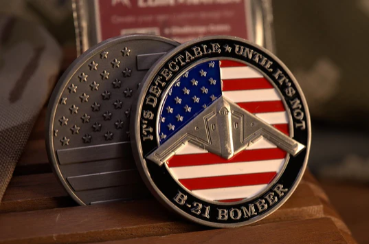











Leave a comment